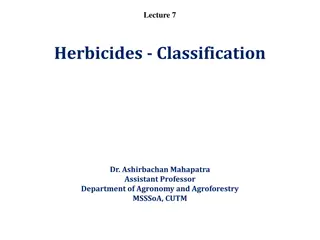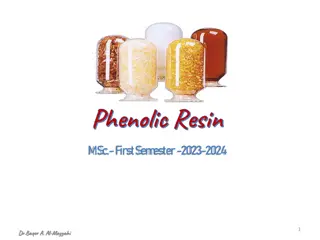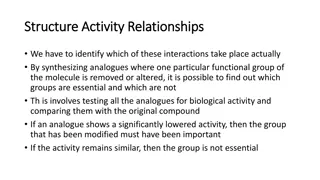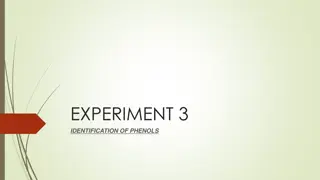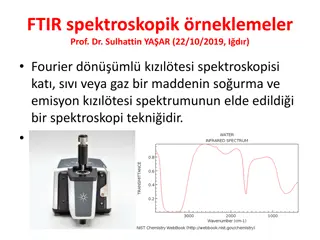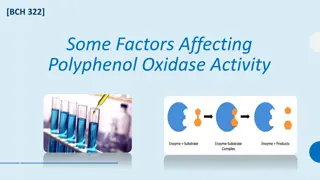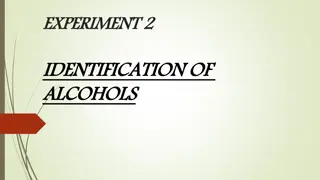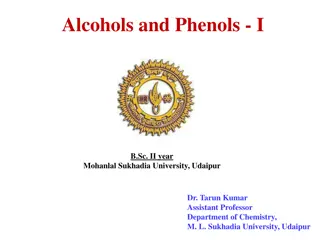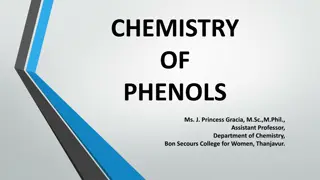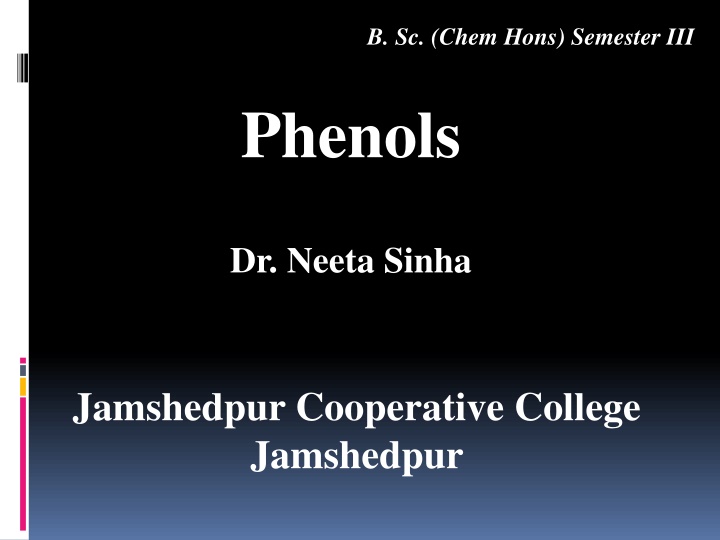
Chemistry Honors Semester III: Phenols Nomenclature, Structure, Synthesis, and Properties
Explore the nomenclature, structure, synthesis, and properties of phenols in Chemistry Honors Semester III. Understand the general formula, structure, synthesis methods, and key properties of phenols such as boiling points and solubility. Gain insights into the chemical characteristics and applications of phenols in various industries.
Download Presentation

Please find below an Image/Link to download the presentation.
The content on the website is provided AS IS for your information and personal use only. It may not be sold, licensed, or shared on other websites without obtaining consent from the author. If you encounter any issues during the download, it is possible that the publisher has removed the file from their server.
You are allowed to download the files provided on this website for personal or commercial use, subject to the condition that they are used lawfully. All files are the property of their respective owners.
The content on the website is provided AS IS for your information and personal use only. It may not be sold, licensed, or shared on other websites without obtaining consent from the author.
E N D
Presentation Transcript
B. Sc. (Chem Hons) Semester III Phenols Dr. Neeta Sinha Jamshedpur Cooperative College Jamshedpur
Outline Nomenclature Structure Synthesis Physical and Chemical Properties
Nomenclature Phenols are defined as compounds having hydroxyl group attached directly to a benzene nucleus. Its general formula is ArOH, where Ar is aryl group and - OH is functional group. OH Phenol Or, Benzenol Or, Hydroxybenzene
Nomenclature continued .. CH3 2-Methylphenol OH OH 1,2- Benzenediol OH Cl 2-Chlorophenol OH 4-Nitrophenol NO2 OH
Structure C6H5 O H Angle C-O-H = 109 degree OH In phenol, C-O bond is formed by the overlapping of sp2 orbital of carbon of the benzene nucleus and sp3 orbital of oxygen whereas O-H bond is formed by the overlapping of sp3 orbital of oxygen and 1s orbital of hydrogen . The C-O-H bond angle in phenol is 109 degree. The c-o bond length is slightly less than single covalent bond because of the resonating structure in which C-O bond acquires some double bond character. The oxygen atom is more electronegative than carbon and hydrogen and hence aquires slight negative charge where as carbon and hydrogen aquires slight positive charge. As a result phenol has a dipole moment of 1.54 D.
Synthesis 1. From Chlorobenzene ( Dow s process ) - When chlorobenzene is treated with 10% NaOH solution at 3550 C and 300 atm pressure using Cu as catalyst to produce phenol after acidification. 10%NaOH/ 3550/Cu HCl C6H5Cl C6H5ONa C6H5OH Chlorobenzene Sodium phenoxide Phenol 2. From sulphonic acid Phenols can be prepared by heating benzene sulphonic acid or their salts with NaOH at 3000 C followed by acidification . NaOH fuse/300 deg.C Dil. HCl C6H5SO3Na C6H5ONa C6H5OH 3. From the hydrolysis of diazonium salt - In this method diazinium salt solution is added to boiling dilute sulphuric acid, phenol is obtained. H2SO4 / Heat C6H5N2Cl C6H5OH Phenol + - Phenol
Synthesis continued. 4. From Grignard reagent Phenols are prepared by bubbling oxygen through etherial solution of Grignard reagent followed by acidification. O2 H+ /H2O C6H5MgBr C6H5OMgBr C6H5OH Phenol 5. From aniline In this process aniline is first diazotised and then hydrolised to get phenol. Diazotised Dil. H2SO4 + - C6H5NH2 C6H5N2Cl C6H5OH
Properties 1. Boiling points Like alcohols, boiling point of phenol is also higher than the corresponding aromatic hydrocarbon. This is because like alcohols , phenols also form intermolecular hydrogen bond. H O ..H O .H-O I I I C6H5 C6H5 C6H5 2. Solubility Phenols are soluble in water, again here because of the formation of intermolecular hydrogen bond with water molecule. H O ..H O .H-O . I I I C6H5 H C6H5
Properties continued .. 3. Acidic nature - Phenols are weakly acidic because it ionises to give phenoxide ion and hydrogen ion. Because of the formation of H+ ion , this is acidic and also the phenoxide ion is resonance stabilised. C6H5OH C6H5O- + H+ Phenoxide ion Alcohols are weaker acid than phenol. Alcohol ionises as R O H RO- + H+ Alkoxide ion Due to + I effect of alkyl gr. , the electron density increases around oxygen and hence tendency of ionisation of alcohol decreases to release H+ ion . Secondly the alkoxide ion formed is not stabilised by resonance like phenoxide ion. The acidic strength of phenol is also affected by the presence of substituent. The electron withdrawing groups like nitro, cyano, chloro increases the acidic strength because of the further dispersal of negative charge in phenoxide ion and further stabilises it whereas electron releasing groups like alkyl, alkoxy, decreases the acidity because these grs. Intensify the negative charge and destabilises the phenoxide ion.
Properties continued .. 4. Acylation ( Fries rearrangement) - Phenol when reacts with acid chloride or acid anhydride corresponding esters are formed. C6H5OH + CH3COCl C6H5OCOCH3 + HCl C6H5OH + ( CH3CO)2O C6H5OCOCH3 + CH3COOH 5. Electrophilic subtitution reaction Phenol is ortho, para directing because OH group increases the electron density at these position. i) Nitration - Nitration of phenol with dilute nitric acid gives the mixture of ortho & para nitrophenol. C6H5OH NO2 NO2 OH + OH Halogenation - Halogenation of phenol gives 2,4,6- trisubstituted product. ii) Br2/H2O C6H5OH Br Br OH Br If solvent is non-polar then 2-bromo & 4-bromophenol is obtained.
Properties continued . iii) Sulphonation - At low temperature phenol gives ortho product whereas at higher temperature it gives para product with H2SO4. H2SO4 C6H5OH OH Low temp SO3H H2SO4 SO3H C6H5OH OH High temp
Properties continued. iv) Friedel craft alkylation Alkylation of phenol gives the mixture of o- & p- products with poor yield. CH3 CH3Cl /anhy AlCl3 C6H5OH OH CH3 + OH v) Kolbe s reaction When sodium salts of phenol is treated with carbon dioxide at 125 degree c under pressure followed by acidification gives salicylic acid. COOH C6H5OH OH vi) Reimer Tiemann reaction When phenol is treated with chloroform and NaOH , mixture of ortho and para hydroxy benzaldehyde are formed. CHO OH CHO OH + C6H5OH
Properties continued . vii) Gattermann synthesis - Phenol on treatment with HCN/ HCl in presence of anhy. AlCl3 produce parahydroxybenzaldehyde. C6H5OH CHO OH viii) Laderer Manasse reaction - In acidic or alkaline medium , phenol condences with aromatic or aliphatic aldehyde to produce ortho & para hydroxybenzyl alcohol. CH2OH HCHO / H+ or OH- C6H5OH OH OH + CH2OH ix) Hauben Hoesch reaction It involves acylation of highly reactive triphenol in presence of CH3CN, HCl and anhy. AlCl3. OH COCH3 C6H5(OH)3 OH OH
Properties continued .... x) Williamson s synthesis - In Williamson s synthesis ether is prepared by heating sodium or potassium salts of phenol with alkyl halide. C6H5ONa + CH3I C6H5OCH3 + NaI Methylphenyl ether C6H5OK + C2H5Br Ethylphenyl ether C6H5OC2H5 + KBr

